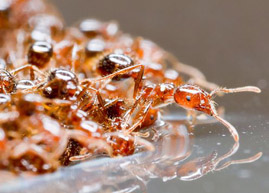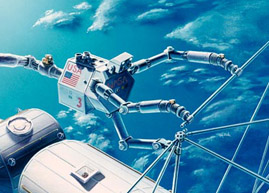Engineers and evolutionary biologists in Scotland and France recorded the boatman—which is roughly the size of a grain of rice—”singing” in a tank. The aquatic insect’s songs peaked at 105 decibels, roughly equivalent to the volume of a pounding jackhammer within arm’s reach.
Category
Science

3-D printers launch small businesses
Andreas, an IT guy in Austria who didn’t want his last name used for this article, started out as a hobbyist. He customizes Lego ”minifigs” — the plastic characters that come with a Lego toy set — to create historically accurate dioramas, or three-dimensional models.
Lego had stopped making a specific hat that made his Napoleonic figures accurate. With no experience in product design and no access to a factory, he designed a new hat and had it 3-D printed.

Fire Ant Swarms Form Living Life Rafts
When a city floods, humans stack sandbags and raise levees. When a fire ant colony floods, the ants link up to form a literal life raft, such as the one pictured. Now, new research shows exactly how the ants manage this feat. Engineering professor David Hu and graduate student Nathan J. Mlot at Georgia Institute … Continue Reading
5 Great Gadgets For Small Business
You can save time, money and a bit of your sanity with these tech devices designed for entrepreneurs. #1: Square Businesses that accept plastic have an easier time getting customers to pay up — and pay on time. But many small businesses don’t have the infrastructure to take credit cards, which usually require signing up … Continue Reading
Oil-Reliant Islands Seek Green Energy Restart
“These are not rich communities,” says Adam Warren, group manager for the deployment group of the U.S. Department of Energy’s National Renewable Energy Laboratory (NREL). “It really put people in a bind. I think island leaders know if oil goes back up to $140 a barrel and they haven’t done anything, they’ll be held responsible.”
Ray Cats, Artificial Moons, And The Atomic Priesthood
How about picking up the latest issue (Mar-Apr 2011) of Mental_Floss? You’ll find my piece on nuclear waste disposal, with all the crackpot theories that were once proposed, is on pages 30 and 31.

Five Forerunners of NASA’s Robot Astronaut
These days, plenty of robots have landed on other planets and been put to work. Still, building a machine that can operate in microgravity around humans but without human control was a unique challenge. The mature, responsible R2 owes its shot at glory in space to a host of robotic “ancestors,” earlier androids that never left Earth as well as less human-like machines that are already hard at work on the ISS.
Upgrading the Electric Grid With Flywheels and Air
Because wind power is generated only when the wind blows, and solar energy isn’t collected on a cloudy day, technologies that can store extra power when it’s not being used and mete it out when needed are becoming increasingly important.
Astronauts Walk on “Mars,” Start Experiments
Since June 2010 six men—three Russians, two Europeans, and one Chinese—have been living in isolation in a 19,423-cubic-foot (550-cubic-meter) “spaceship” outside Moscow, doing maintenance work, conducting experiments, and trying to stave off boredom by playing Rock Band and reading the complete works of Gabriel García Márquez.
New Invisibility Cloak Closer to Working “Magic”
Harry Potter and Bilbo Baggins, take note: Scientists are a step closer to conquering the “magic” of invisibility.
Many earlier cloaking systems turned objects “invisible” only under wavelengths of light that the human eye can’t see. Others could conceal only microscopic objects. But the new system, developed at Massachusetts Institute of Technology and the Singapore-MIT Alliance for Research and Technology (SMART) Centre, works in visible light and can hide objects big enough to see with the naked eye.